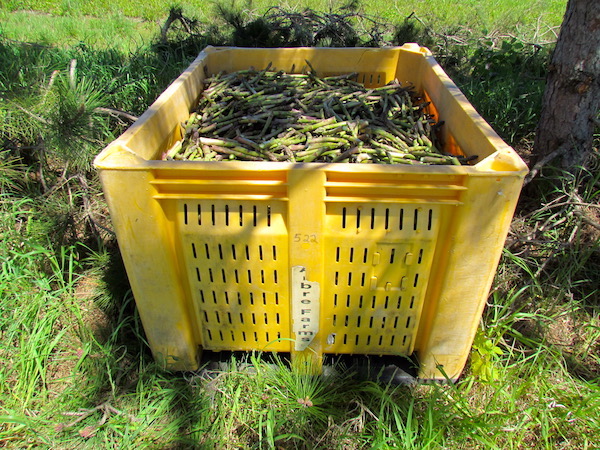Above: Barb and Harry Norconk, of Norconk Farm.
Note: Photos for this story were taken June 2019, prior to the mask-wearing protocols required during the COVID-19 pandemic.
The startling thing about an asparagus field at harvest time is it doesn’t look like any harvest-ready field you’ve ever seen. Forget leafy green spread of bounty. Think bare soil and weathered mulch with some little stalks protruding.
But as this day at Norconk Farm, in Empire, Michigan, proves, an asparagus field, though not lush, is full of luscious food. From the soil rises some of the finest asparagus stalks to be found anywhere. The thick spears of green and purple are what you’d expect at the nation’s best grocery stores or on plates at the best restaurants. Today’s Norconk asparagus, however, is going to feed vulnerable individuals and families at food pantries in a six-country region of northwest lower Michigan: Grand Traverse, Leelanau, Wexford, Benzie, Antrim and Kalkaska Counties. The pantries are all part of the Northwest Food Coalition.

The harvest is part of an innovative program called Farm to Neighbor in which donations pay for crops that go to food pantries. On this particular day, Harry and Barb Norconk are selling 850 pounds of asparagus, which will be distributed in 20-pound deliveries to dozens of food pantries and meal sites. Now in its third year, Farm to Neighbor has increased farm purchases from one a month to often two or three a month.
A key partner in the food pantry distribution program is Good Will Northern Michigan’s Food Rescue, which operates the trucks, warehouse and repacking operation that delivers the food to the pantries.
The system is on display this sunny June morning at Norconk Farm. Harvesters inch through the field on a specially adapted cart. They stop occasionally to place asparagus in a field-side bin. Once the harvested asparagus is inside the Norconk processing barn, Harry measures out bundles of the spears in rows and grabs a knife. He works quickly down the row, trimming neatly to equal lengths. Surrounding Harry in the barn is evidence of the farming life. Dozens of tools—shovels, pitchforks, sledge hammers, axes, and more hang on the wall. A large scale stands ready to weigh bundles. Solstice-time light pours in through the open barn-doors and gleams in the eyes of Harry and Barb.

“I began farming asparagus in 1978,” Harry says, looking out the big open doors at the fields. “An asparagus plant will produce for about 10 to 15 years.” But as with any crop, the farmer must deal with the uncertainties of weather and disease. “I had to spend several thousand dollars treating that field a few years ago before we planted it.”
Soon, Taylor Moore, with Goodwill Northern Michigan’s Food Rescue, drives up in a Goodwill cargo van, and Harry heads into a spacious walk-in cooler. He quickly returns, pushing a cart of perfect asparagus, and heads back to fetch more. It’s all destined for packing into 20-pound bags the next morning at Food Rescue.

Nearly all of the farms in the Farm to Neighbor program have donated produce to food pantries in the past. “They donate excess product or invite us out to glean at the farm,” Moore says. This is the third year Norconk has donated. “Just as Food Rescue supports farmers to have their produce rescued, we are supporting the pantries to purchase more produce from local farms—creating a loop that benefits our community,” he says. “Farmers work tirelessly, and it’s an uphill battle,” Moore says. “But they are very generous.”
Moore hopes the Farm to Neighbor program will inspire food pantries to tap into their traditional budgets and purchase even more food from local farmers, so this method of sourcing food would become standard practice. All together, the food pantries in the six-county region spend about $1 million annually on food purchases.
Also central to the operation is Groundwork Food Equity Specialist Christina Barkel, who coordinates the communication and purchasing between local farmers and food pantries. “My passion is food equity and access,” she says. “This work marries those two parts of my life. We pay farmers for this food they are growing. And we take the highest quality food and make that accessible to people in our region who can’t afford that food.” In this way, Farm to Neighbor exemplifies the twin pillars of local food value: healthier, nutrient-dense food for consumers and improved economic stability for farmers.

One aspect of Farm to Neighbor that Barkel feels is especially valuable is that monthly crop choices are coordinated with a school food program called Harvest of the Month. The Harvest of the Month recipe cards and information that kids see in school are made available to food pantry clients, so they can learn about the produce and share that information with their families. The theory: When children learn about fresh produce in school, they are more likely to ask their parents for it at the store or food pantry. When people get information about where their food comes from and how to prepare it, it becomes a more appealing choice. That’s how the seeds of healthy food culture begin to sprout.
The morning after the asparagus harvest at Norconk, Christina is at the GoodWill Northern Michigan food warehouse where the repacking happens. The bins of asparagus from Norconk roll out from the cooler, and a half-dozen food pantry coordinators reach to grab handfuls of the spears. They gently place them into bags sitting on the scale. When the pointer edges up to 20 pounds, somebody ties the bag. A route tag is attached—three routes, each a different color tag.
“For me, that’s the best moment,” Christina says. “When we were repacking the asparagus and seeing how beautiful it was, and hearing the excitement of the food pantry coordinators about how good the food was and knowing they’d be taking it to their clients. That is the moment.”




